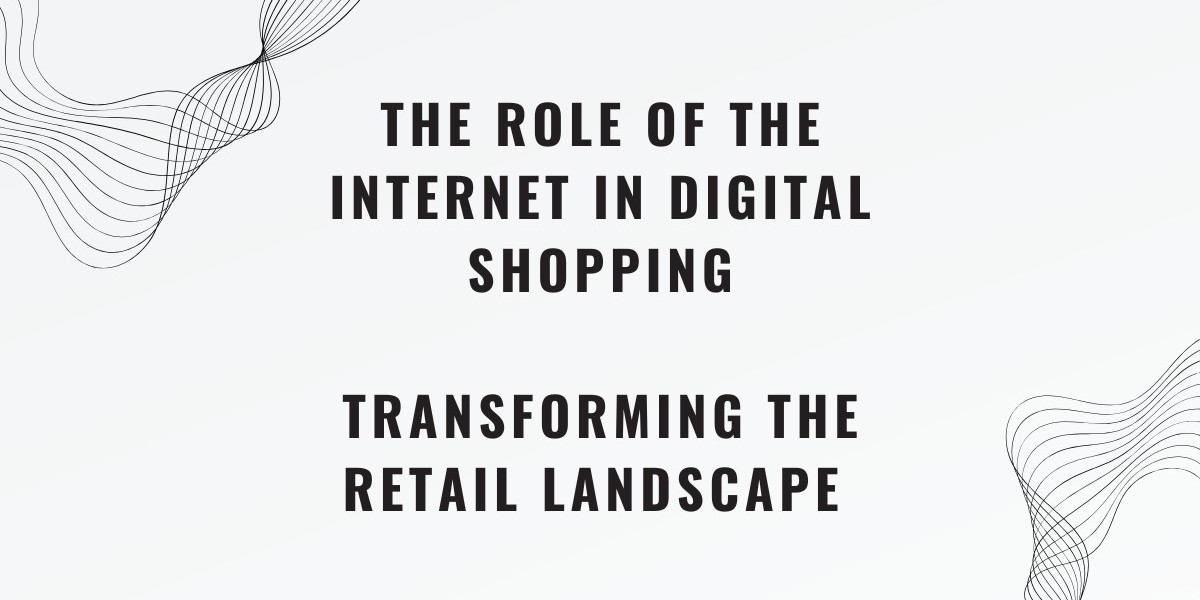Introduction
In the digital age, the internet has revolutionized shopping, turning traditional brick-and-mortar stores into digital marketplaces accessible with a few clicks. Digital shopping, powered by the internet, has grown exponentially in recent years, reshaping how consumers browse, compare, and purchase products. This blog explores the profound impact of the internet on digital shopping, its benefits, challenges, and the future of online retail.
The Emergence of Digital Shopping
Digital shopping, or e-commerce, leverages the internet to enable the buying and selling of goods and services online. From small businesses to global enterprises, companies now use digital platforms to reach a vast audience. Key milestones in the rise of digital shopping include:
- The launch of Amazon (1994), which set the stage for global e-commerce.
- The introduction of secure online payment methods, increasing consumer trust.
- The growth of mobile technology, making shopping accessible anytime, anywhere.
Benefits of Internet-Driven Digital Shopping
1. Convenience
The internet allows consumers to shop 24/7 without leaving their homes. Whether it’s groceries, clothing, or electronics, digital platforms cater to every need.
2. Wider Selection
E-commerce sites offer an extensive range of products that physical stores may not have space to stock. Customers can browse global inventories at their leisure.
3. Price Comparisons
The internet simplifies comparing prices across multiple platforms, helping customers find the best deals without manual research.
4. Personalized Shopping Experiences
Websites use data analytics and algorithms to offer personalized recommendations based on browsing history and preferences.
5. Time Savings
Digital shopping eliminates the need to commute, wait in queues, or browse physical aisles, saving time for busy consumers.
6. Access to Reviews
Customer reviews and ratings provide insights into product quality, helping consumers make informed decisions.
How the Internet Has Transformed Retail Businesses
1. Global Reach
The internet enables businesses to expand beyond geographical boundaries, attracting customers worldwide.
2. Cost Efficiency
Digital platforms reduce operational costs, such as maintaining physical stores and hiring staff. This allows businesses to offer competitive prices.
3. Data-Driven Insights
Online shopping platforms collect data on consumer behavior, enabling businesses to tailor marketing strategies and optimize inventory.
4. Omnichannel Experiences
Retailers integrate physical and digital shopping experiences, providing seamless transitions between in-store and online purchases.
Challenges in Digital Shopping
Despite its numerous advantages, internet-driven shopping has its challenges:
1. Security Concerns
Cybersecurity threats, such as phishing and data breaches, can deter customers from trusting online platforms.
2. Logistics and Delivery Issues
Shipping delays, lost packages, and high delivery costs can affect customer satisfaction.
3. Lack of Tangibility
Consumers cannot physically inspect or try products before purchase, which can lead to dissatisfaction.
4. Return and Refund Complexities
Navigating return policies and processing refunds can sometimes be a hassle for customers.
5. Digital Divide
Not everyone has equal access to the internet or digital devices, limiting the reach of online shopping in certain regions.
Popular Categories in Digital Shopping
The internet supports a wide range of shopping categories, with some of the most popular being:
- Fashion and Apparel
Clothing, shoes, and accessories dominate e-commerce platforms.
- Electronics
Smartphones, laptops, and gadgets are hot sellers online.
- Groceries
Online grocery delivery services have seen tremendous growth, especially post-pandemic.
- Health and Beauty
Skincare, cosmetics, and fitness equipment are in high demand.
- Home and Furniture
Consumers enjoy browsing extensive catalogs of furniture and décor online.
- Digital Goods
Subscriptions, e-books, and software are popular in the digital shopping sphere.
The Role of Mobile Devices in Digital Shopping
Mobile technology has further transformed digital shopping, with smartphones and apps becoming the preferred medium for online purchases.
- Mobile-First Design
Websites are optimized for mobile browsing to cater to on-the-go users.
- Push Notifications
Retailers send alerts about sales, discounts, and new arrivals directly to users’ devices.
- In-App Purchases
Dedicated shopping apps provide a smoother and faster experience.
The Impact of Social Media on Digital Shopping
Social media platforms like Instagram, Facebook, and Pinterest have become integral to e-commerce. Features like **shoppable posts**, **live shopping**, and **product tagging** make it easy for users to shop directly from their social feeds. Influencer marketing further drives consumer interest by showcasing products in real-world contexts.
The Future of Internet-Driven Digital Shopping
1. Artificial Intelligence (AI)
AI will continue to enhance personalization, virtual assistants, and predictive analytics in shopping.
2. Augmented Reality (AR)
AR tools will allow customers to virtually try on clothing, test furniture in their homes, or sample makeup shades.
3. Blockchain Technology
Blockchain will ensure secure transactions, reduce fraud, and improve transparency in supply chains.
4. Sustainability Focus
Eco-conscious consumers will demand more sustainable practices, including greener packaging and energy-efficient delivery methods.
5. Voice Commerce
With the rise of smart assistants like Alexa and Google Home, voice-based shopping is expected to grow.
Conclusion
The internet has fundamentally transformed shopping, making it faster, more convenient, and accessible to a global audience. As technology continues to evolve, digital shopping will only become more seamless, personalized, and secure. Businesses must adapt to these trends to thrive, while consumers can look forward to an even more engaging online shopping experience.
FAQs
- What is digital shopping?
- Digital shopping refers to purchasing goods and services online through e-commerce platforms or apps using the internet.
- How has the internet impacted shopping habits?
- The internet has made shopping more convenient, providing access to global products, competitive prices, and personalized recommendations.
- What are the advantages of digital shopping?
- Convenience, time savings, wide product selection, easy price comparisons, and access to reviews are major advantages.
- What are the risks of digital shopping?
- Cybersecurity threats, delivery issues, and the inability to physically inspect products are common challenges.
- How can I ensure secure online shopping?
- Shop from reputable websites, use secure payment methods, and avoid sharing personal information on unverified platforms.
- What is the role of mobile devices in digital shopping?
- Mobile devices make online shopping more accessible, with apps and mobile-optimized websites providing a user-friendly experience.
- How does social media influence online shopping?
- Social media platforms offer shoppable posts, product recommendations, and influencer promotions that drive online purchases.
- What trends are shaping the future of digital shopping?
- AI, AR, blockchain technology, voice commerce, and sustainability are key trends in online retail.
- Can small businesses succeed in digital shopping?
- Yes, small businesses can thrive by creating user-friendly websites, leveraging social media, and offering unique products.
- How has COVID-19 impacted digital shopping?
- The pandemic accelerated the shift to online shopping, with more consumers relying on e-commerce for essential and non-essential purchases.



